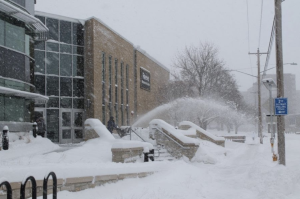UW Oshkosh Grounds Maintenance Department struggles with snow removal
February 26, 2020
Budget cuts at UW Oshkosh have taken a toll on the Grounds Maintenance Department as it’s currently understaffed and using old equipment to remove snow from campus, according to university officials.
The department only has nine employees to clear 17 miles of sidewalk and 30 acres of plowable space, grounds and auto shop superviser Lisa Mick said.
Two of those employees also serve as mechanics, who fix equipment when it breaks down. Mick said this winter has been especially bad for breakdowns, causing the mechanics to plow “half as much” as they normally do.
Most of the equipment is about 12 to 15 years old and the budget won’t allow the grounds department to purchase updated trucks, she noted.
The plows work best if they take three inches of snow off at a time, Mick said.
She added that the plows have been used on one inch of snow more often this year than in other years, causing additional wear and tear on the vehicle.
“When you’re driving a truck and you’re banging it around on pavement, there’s really no way to avoid it,” she said.

UW Oshkosh Grounds and Maintenance Department is understaffed due to budget cuts.
Employee retirements have also become a problem because the university doesn’t fill open positions when employees retire, Mick said.
The staff reductions force the department to do more with less, causing them to juggle priorities and increasing the time it takes to clear the campus, she added.
“You can say, ‘we’ve got to make these cuts,’ but for [the grounds department], the amount of acreage and the amount of miles that we plow doesn’t change from year to year,” she said.
For each snowfall, Mick starts planning the day before, watching for when the snow is expected to start and for how heavy it’s expected to be.
Because she lives in Fond du Lac, Mick said she sometimes sleeps at the grounds department auto shop overnight to avoid getting into a traffic accident during major snowstorms.
“My husband works for a golf course; he removes snow too, so he gets it,” Mick said. “He’s just happy that I’m safe.”
On average, she said crews begin working to remove snow at about 2 a.m., but sometimes they start at 11 p.m. or midnight. If she has extra workers pitching in from other departments, the crew sometimes starts at 4 a.m.
Plowing and shoveling the campus takes about five to six hours with a full 12-person crew, but with a nine-person crew it can take eight hours or more, she said.
For example, Mick said that if eight inches of snow are expected, crews will plow at 11 o’clock the night before the snow is expected to end and then come back at 2 a.m. and plow until the snow is cleared, which can sometimes take until 8 a.m.
“At first my guys were really excited about the overtime,” she said. “But now they’re starting to get burned out.”
She added that custodians are responsible for snow removal within 25 feet from buildings.
The university has also developed a priority map that identifies key areas on campus that need to be cleared first based on previously identified problem areas and accessibility needs for students in wheelchairs, according to UWO Environment, Health and Safety Coordinator Lori Welch.
“The accessibility coordinator at student services makes sure that [the grounds department] has that information by the time snow starts falling,” Welch said.
In terms of salt use, Mick said the grounds crew uses about five tons of ice melt for each snowfall where it is needed.
Some snowfalls don’t require salt because sometimes the temperature rises fast enough that salt isn’t necessary, she said.
She added that the university spends roughly $35,000 on salt each year.
“Budgets might be cut, but it’s not like we’re holding back on the amount of salt we’re buying,” she said.
In addition to the grounds department’s efforts, UWO’s Risk and Safety Office was recently awarded a grant from the state Department of Administration to reduce slips, trips and falls based on data from previous years.
Welch said the grant was to reduce workers compensation claims and is being used to supply the grounds crew, facility management crews and university police with shoe spikes.
Beyond the grant, the Risk and Safety Office has also developed a “Winter Weather Action Plan” that promotes safe traveling on campus.
The plan recommends students wear slip-resistant footwear in the winter months and watch out for ice when walking across campus.
Beside the action plan, students can also use the UWO Mobile app to report icy areas on campus. Once a problem area is reported, grounds crews are notified to take appropriate action to remove ice.
“Students should report icy areas so we can know if it’s a chronic problem area,” Mick said. “We can’t solve a problem if we don’t know about it.””













